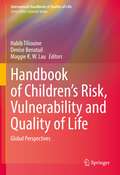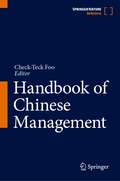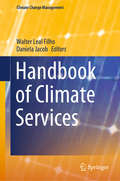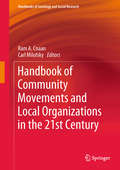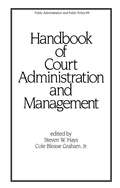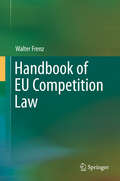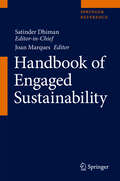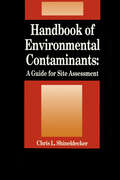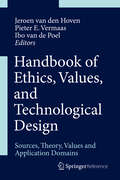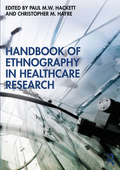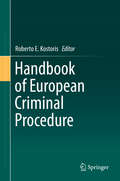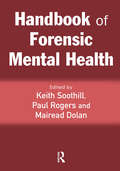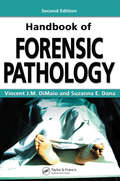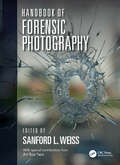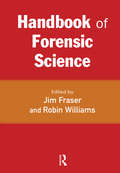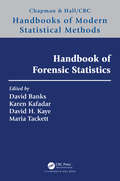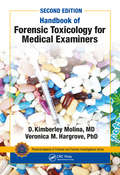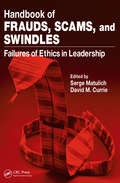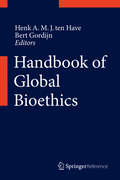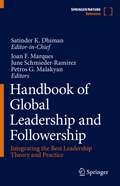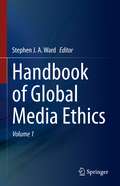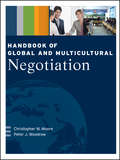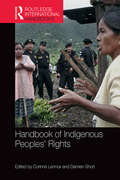- Table View
- List View
Handbook of Child and Adolescent Psychopathy
by Randall Salekin Donald LynamThis comprehensive handbook synthesizes the rapidly growing research base on child and adolescent psychopathy: its nature, causes, development, assessment, and treatment. The editors and contributors are leading authorities who review state-of-the-art empirical findings and weigh in on pressing questions, such as how the disorder should be conceptualized in youth and how to evaluate it in clinical and forensic contexts. Available assessment instruments and intervention approaches are critically examined. Etiological theories are presented that shed light on a range of potential causal mechanisms, including genetics, brain functioning, temperament, family processes, and other factors.
Handbook of Children’s Risk, Vulnerability and Quality of Life: Global Perspectives (International Handbooks of Quality-of-Life)
by Habib Tiliouine Maggie K. W. Lau Denise BenatuilThis handbook makes a major contribution to the growing international research and policy interest in children’s experienced well-being or quality of life in childhood, linking it to ongoing research on children’s risk and vulnerability. The editors and contributors adopt the broader concept of ‘risk’ in addition to ‘vulnerability’. Not much work considers the connections between risks that children experience and their quality of life. In examining children’s quality of life, the chapters discuss various issues of risk and vulnerability that may affect their lives and also how the quality of childhood might be enhanced and maintained even in the face of these factors. The chapters discuss experiences of violence and abuse; access to basic services such as housing, health and education; and children’s vulnerability due to broader external factors such as war, conflict, and environmental events. The volume also includes the impacts of new technologies on children and the consequent risks and vulnerabilities they may face, alongside the benefits.This important volume brings together a diverse range of perspectives from established experts and emerging scholars in these fields of work. It covers a wide range of geographical and cultural contexts, and includes theoretical, empirical, policy and practice-based contributions. This handbook is a natural first point of reference for academics and policy professionals interested in quality of life, well-being, and children's rights.
Handbook of Chinese Management
by Check-Teck FooThis handbook explores the theme of managing inside China and consists of chapters that communicate the major managerial concepts within the context of Mainland China. Its key emphasis is to clearly highlight the differences in the art of managing in China vs. the West, while acknowledging that these differences may be narrowing as a result of globalization. Chapters in the book elaborate on how management is affected as China experiences rapid change while some aspects of Chinese culture remain unchanged and steeped in tradition. The book goes further in exploring this complexity by juxtaposing China’s orientation towards interpersonal relations, or "guanxi", with the government’s emphasis on law, which is now becoming more rule-based than before. Business & Management academics and practitioners will gain useful insight into Chinese management practices and their contrast to established Western ones when they use the Handbook of Chinese Management as a reference.
Handbook of Climate Services (Climate Change Management)
by Walter Leal Filho Daniela JacobThis book explores climate services, including projections, descriptive information, analyses, assessments, and an overview of current trends. Due to the pressures now being put on the world’s climate, it is vital to gather and share reliable climate observation and projection data, which may be tailored for use by different groups. In other words, it is essential to offer climate services. But despite the growth in the use of these services, there are very few specialist publications on this topic. This book addresses that need. Apart from presenting studies and the results of research projects, the book also offers an overview of the wide range of means available for providing and using climate services. In addition, it features case studies that provide illustrative and inspiring examples of how climate services can be optimally deployed.
Handbook of Community Movements and Local Organizations in the 21st Century (Handbooks Of Sociology And Social Research Ser.)
by Ram A. Cnaan Carl MilofskyThis new handbook builds on The Handbook of Community Movements and Local Organizations published in 2007, and is the only resource defining the field of study related to small nonprofit organizations and to studying communities from the standpoint of associations that make up communities. It explores the history and conceptualizations of community, theoretical concepts in community organizations, social movements ranging from health to crime, and community practice methods. Further it provides authoritative statements of major theory areas, gives examples of different sub areas of the field, provides guidance to people working as practitioners in the field, and nicely coincides with the increasing interest in clinical sociology. This handbook is of great interest to academics, students and practitioners with an interdisciplinary resource to understand and collaborate in work with contemporary communities.
Handbook of Contract Management in Construction
by Ali D. HaidarThis book addresses the process and principles of contract management in construction from an international perspective. It presents a well-structured, in-depth analysis of construction law doctrines necessary to understand the fundamentals of contract management. The book begins with an introduction to contract management and contract law and formation. It then discusses the various parties to a contract and their relevant obligations, whether they are engineers, contractors or subcontractors. It also addresses standard practices when drafting and revising contracts, as well as what can be expected in standard contracts general clauses. Two chapters are dedicated to contract clauses, with one focused on contract administration such as schedules, payment certificates and defects liability, and the other focused on contract management, such as terminations, dispute resolutions and claims. This book provides a useful reference to engineers, project managers and students within the field of engineering and construction management.
Handbook of Court Administration and Management (Public Administration And Public Policy Ser. #49)
by HaysBlending both the theoretical and applied aspects of contemporary issues in court management, this reference/text offers in-depth coverage of all major topics and developments in judicial systems administration. It is suitable for use in the classroom or for self-study.;Providing the background material to clarify even the most technical management application, this book: presents the history and theory of the court management movement; examines the separation of powers doctrine, and its relationship to judicial independence; discusses the latest developments in court reform, the American Bar Association standards, alternative dispute resolution techniques and caseflow considerations; analyzes unified court budgeting and revenue generation by judicial systems; describes personnel administration, training and jury management; and elucidates court performance evaluation, planning approaches, the use of cameras in the courtroom and audio-visual applications.
Handbook of EU Competition Law
by Walter FrenzThis handbook offers detailed descriptions of EU competition law, including mergers and public authorities. Above all, it analyzes and discusses recent decisions of the ECJ and the General Court. Presenting systematically structured and theoretically founded content, the book also includes recommendations for practitioners. Special attention is paid to the scope of penalties and the influence on fundamental rights. Rounding out the book, the conflict between safeguarding confidential information and the effectiveness of private and public enforcement is discussed intensively in the context of the new Directive 2014/104/EU.
Handbook of Engaged Sustainability
by Satinder Dhiman Joan MarquesThis handbook is based on the premise that in order for sustainability to be sustainable, a profound psychological transformation has to take place at the individual and collective level. Focusing on the practice of environmental sustainability, this handbook will explore the application of sustainability in a wide variety of contemporary contexts—from economics of consumption and growth to government policy, sustainable cities, and sustainable planet. The editors believe that the way to achieve sustainable, harmonious living in all spheres is through lived or engaged sustainability at the personal, team, and organizational levels. It is impossible to separate economic development issues from environment issues. In its most practical aspect, sustainability is about understanding the interconnections among environment, society, and economy. This book aims to provide a comprehensive overview of current theories and approaches in the area of engaged sustainability for academics, researchers and practitioners. Specifically, it will focus on making responsible decisions that will reduce humanity’s negative impact on the environment. While various social and political initiatives for sustainability are welcome, one cannot really enact sustainability into legislative laws. Something has to change fundamentally at the level of a common person in the street. The Handbook of Engaged Sustainability acknowledges the classic literature, theories and principles in the area of sustainability, but also provides new theories and approaches from global scholars and practitioners in the field. It will also provide a well-structured pedagogical framework with real life case examples. The aim of this handbook is to expand the reader’s thinking to one of “big-picture awareness” and a “cosmic vision” of sustainability, a vision that extends from our neighborhoods to our communities, to states, countries, globe, galaxy, and envelops the entire Universe! This book will serve as an essential resource for researchers, scholars and students of sustainability, ethics, corporate social responsibility and environmental economics, as well as consultants, business and team leaders, and anyone interested in engaged sustainability.
Handbook of Environmental Contaminants: A Guide for Site Assessment
by Chris ShineldeckerHandbook of Environmental Contaminants: A Guide for Site Assessment is an indispensable working reference for environmental assessment professionals faced with determining potential environmental contaminants that might be found in the soil, groundwater, or air of a property or facility. The book provides a comprehensive listing of potential contaminants associated with hundreds of industries, activities, and processes. The types of properties covered range from agricultural to heavy industrial. The products and processes covered range from the processing of yeast to the constituents of rocket fuel. The book also discusses products associated with the degradation of common chemical solvents in the environment.Handbook of Environmental Contaminants: A Guide for Site Assessment is an important reference for environmental consultants, workers on Superfund sites, public health and safety professionals, attorneys, educators and students, and lenders.
Handbook of Ethics, Values, and Technological Design
by Ibo van de Poel Pieter E. Vermaas Jeroen van den HovenThis handbook enumerates every aspect of incorporating moral and societal values into technology design, reflects the fact that the latter has moved on from strict functionality to become sensitive to moral and social values such as sustainability and accountability. Aimed at a broad readership that includes ethicists, policy makers and designers themselves, it proffers a detailed survey of how technological, and institutional, design must now reflect awareness of ethical factors such as sustainability, human well-being, privacy, democracy and justice, inclusivity, trust, accountability, and responsibility (both social and environmental). Edited by a trio of highly experienced academic philosophers with a specialized interest in the ethical dimensions of technology and human creativity, this syncretic handbook collates an array of published material and offers a studied, practical introduction to the field. The volume addresses myriad aspects at the intersection of technology design and ethics, enabling designers to adopt a constructive approach in anticipating, preventing, and resolving societal and ethical issues affecting their work. It covers underlying theory; discrete values such as democracy, human well-being, sustainability and justice; and application domains themselves, which include architecture, bio- and nanotechnology, and military hardware. As the first exhaustive survey of a field whose importance is characterized by almost exponential growth, it represents a compelling addition to a formerly atomized literature.
Handbook of Ethnography in Healthcare Research
by Hackett, Paul M.W.This handbook provides an up-to-date reference point for ethnography in healthcare research. Taking a multi-disciplinary approach, the chapters offer a holistic view of ethnography within medical contexts. This edited volume is organized around major methodological themes, such as ethics, interviews, narrative analysis and mixed methods. Through the use of case studies, it illustrates how methodological considerations for ethnographic healthcare research are distinct from those in other fields. It has detailed content on the methodological facets of undertaking ethnography for prospective researchers to help them to conduct research in both an ethical and safe manner. It also highlights important issues such as the role of the researcher as the key research instrument, exploring how one’s social behaviours enable the researcher to ‘get closer’ to his/her participants and thus uncover original phenomena. Furthermore, it invites critical discussion of applied methodological strategies within the global academic community by pushing forward the use of ethnography to enhance the body of knowledge in the field. The book offers an original guide for advanced students, prospective ethnographers, and healthcare professionals aiming to utilize this methodological approach.
Handbook of European Criminal Procedure
by Roberto E. KostorisThis volume analyses criminal procedural issues from a European perspective, particularly in connection with EU law and ECHR law. As such, it differs from previous works, which, on the one hand, generally focus only on EU law, and, on the other, address both procedural and substantial aspects, as a result of which the former receive inadequate attention. Indeed, criminal procedural matters in the European context have now reached a level of complexity, but also of maturity, that shows the features of a great design, which, even if not yet defined in all its aspects, appears sufficiently articulated to deserve to be explained in a systematic way. The book offers a guidance for practitioners, academics and students alike. It covers a broad range of topics: from the complex system of the sources of law to the multilevel protection of fundamental rights; from vertical and horizontal judicial and police cooperation to the instruments of mutual recognition, primarily the European Arrest Warrant; but also the European Investigation Order, the execution of confiscation orders, the ne bis in idem principle, the conflicts of jurisdiction and the enforcement of judgements. The book also reflects the latest regulation on the establishment of the European Public Prosecutor’s Office.
Handbook of Forensic Mental Health
by Paul Rogers Keith Soothill Mairead DolanThis is a comprehensive reference book on the subject of forensic mental health, looking at what forensic mental health is and its assessment, management and treatment. It focuses on key topics and the issues underpinning them in contemporary society. The book includes: an account of the historical development of forensic mental health, along with a description of the three mental health systems operating in the UK an in-depth analysis of the forensic mental health process and system, including an analysis of the different systems applied for juveniles and adults an examination of the main issues in forensic mental health including sex offending, personality disorders and addiction a breakdown of the key skills needed for forensic mental health practice. This is an authoritative reference book which will be a crucial text for practitioners, academics and students in the forensic mental health field.
Handbook of Forensic Pathology
by Vincent J.M. DiMaio M.D. Suzanna E. Dana M.D.Handbook of Forensic Pathology, Second Edition is an up-to-date, concise manual illustrating all core aspects of modern forensic pathology. This edition retains the outline format of the original, which allows for quick access and rapid assimilation. Written in no-nonsense, easily understandable language, this precise and thorough yet compact resou
Handbook of Forensic Photography
by Sanford L WeissHandbook of Forensic Photography is the most-comprehensive, definitive reference for the use of photography in the capture and presentation of forensic evidence. The intent is to inform the reader about the most complete and up-to-date methods to capture and reproduce images that most accurately represent the evidence. With the rise in importance of forensic science, crime and accident scene documentation has likewise increased in importance—not the least of which has been forensic photography. The need to use accepted practice and protocols to guarantee the authenticity of images for evidence documentation is paramount for using it in court. And as with any discipline, there is an art to the science of forensic photography. Contributing authors from various backgrounds—each experts in their field—have provided numerous case examples, best practices, and recommendations for recognizing, recording, and preserving evidence using cameras and the latest digital image technology, including video and other imaging technologies. Chapters present such topics as videography, drone photography, underwater photography, crime scene photography, autopsy photographs, fire documentation, forensic odontology, and more. The book closes with coverage of courtroom displays, presenting imaging evidence and expert witness testimony in the courtroom. Handbook of Forensic Photography is a must-have reference for experienced crime scene photographers, death and crime scene investigators, police, and forensic professionals—including medical examiners, odontologists, engineers, and forensic anthropologists—who frequently need to capture investigative photographs in the course of investigations.
Handbook of Forensic Science
by Robin Williams Jim FraserForensic science has become increasingly important within contemporary criminal justice, from criminal investigation through to courtroom deliberations, and an increasing number of agencies and individuals are having to engage with its contribution to contemporary justice. This Handbook aims to provide an authoritative map of the landscape of forensic science within the criminal justice system of the UK. It sets out the essential features of the subject, covering the disciplinary, technological, organizational and legislative resources that are brought together to make up contemporary forensic science practice. It is the first full-length publication which reviews forensic science in a wider political, economic, social, technological and legal context, identifying emerging themes on the current status and potential future of forensic science as part of the criminal justice system. With contributions from many of the leading authorities in the field it will be essential reading for both students and practitioners.
Handbook of Forensic Statistics (ISSN)
by David Banks, Karen Kafadar, David H. Kaye and Maria TackettHandbook of Forensic Statistics is a collection of chapters by leading authorities in forensic statistics. Written for statisticians, scientists, and legal professionals having a broad range of statistical expertise, it summarizes and compares basic methods of statistical inference (frequentist, likelihoodist, and Bayesian) for trace and other evidence that links individuals to crimes, the modern history and key controversies in the field, and the psychological and legal aspects of such scientific evidence.Specific topics include uncertainty in measurements and conclusions; statistically valid statements of weight of evidence or source conclusions; admissibility and presentation of statistical findings; and the state of the art of methods (including problems and pitfalls) for collecting, analyzing, and interpreting data in such areas as forensic biology, chemistry, and pattern and impression evidence. The particular types of evidence that are discussed include DNA, latent fingerprints, firearms and toolmarks, glass, handwriting, shoeprints, and voice exemplars.
Handbook of Forensic Toxicology for Medical Examiners (Practical Aspects of Criminal and Forensic Investigations)
by D. K. Molina, M.D. Veronica HargroveForensic professionals, particularly medical examiners—often working through heavy caseloads—require quick and easy access to reliable sources of information to help interpret toxicology results. While several in-depth resources are available, they are often large, cumbersome, and contain more information than is often needed. The Handbook of Forensic Toxicology for Medical Examiners is a concise handbook referencing the most common toxic substances and their reported non-toxic, toxic, and lethal concentrations, making it an ideal text for quick reference in the lab or autopsy room. Features of the Second Edition: Explains the principles of postmortem toxicology and the factors which must be considered Provides tables of toxicologic data for over 200 commonly encountered substances, including drugs of abuse, poisons, prescription drugs, and over-the-counter medications Includes discussion and description of the novel psychoactive drugs—including synthetic opioids, cannabinoids, stimulants and hallucinogens Supplemental appendices provide additional information regarding specimen types and selection, testing methodologies, normal laboratory values, and conversion charts The busy forensic professional needs a concise handbook that provides critical information quickly and accurately. This heavily referenced text offers an easy-to-use format allowing for rapid access for both routine daily use and preparation for courtroom testimony.
Handbook of Frauds, Scams, and Swindles: Failures of Ethics in Leadership
by David M. Currie Serge MatulichIt has been said that scammers and swindlers often display characteristics commonly attributed to good leadership. These include setting a vision, communicating it clearly, and motivating others to follow their lead. But when these skills are used by unconscionable people to satisfy greed, how can the average person recognize that foul play is afoo
Handbook of Global Bioethics
by Bert Gordijn Henk A.M.J. ten HavePresents information and analysis concerning the state of affairs in bioethics in approximately 50 countries. In this title, readers can orientate themselves quickly as regards the various relevant issues, institutional structures and expertise available in these countries.
Handbook of Global Leadership and Followership: Integrating the Best Leadership Theory and Practice
by Satinder K. DhimanThis handbook integrates the best leadership and followership theories and practices between the Global North-West (countries of Western individualistic cultures in Europe, North America, Australia and Oceana) and the Global South-East (countries of Eastern collectivistic cultures in Asia, Africa, South America, and South-East Asian and Oceana). There is a need to bring the Global North-West and the Global South-East together to address global challenges such as the climate change, global hunger and poverty, domestic and international terrorism, social justice, gender inequality, and domestic and global abuse of human and natural resources. This innovative volume proposes that the democratic leadership of the Global North-West and the human-centered followership of the Global South-East can transform the world if leadership and followership values, education, and practices are integrated. It utilizes findings from positive psychology, social psychology, organizational behavior, and world religions and contemplative wisdom traditions to highlight the case for global leadership and followership.
Handbook of Global Media Ethics
by Stephen J. A. WardThis handbook is one of the first comprehensive research and teaching tools for the developing area of global media ethics. The advent of new media that is global in reach and impact has created the need for a journalism ethics that is global in principles and aims. For many scholars, teachers and journalists, the existing journalism ethics, e.g. existing codes of ethics, is too parochial and national. It fails to provide adequate normative guidance for a media that is digital, global and practiced by professional and citizen. A global media ethics is being constructed to define what responsible public journalism means for a new global media era. Currently, scholars write texts and codes for global media, teach global media ethics, analyse how global issues should be covered, and gather together at conferences, round tables and meetings. However, the field lacks an authoritative handbook that presents the views of leading thinkers on the most important issues for global media ethics. This handbook is a milestone in the field, and a major contribution to media ethics.
Handbook of Global and Multicultural Negotiation
by Christopher W. Moore Peter J. WoodrowPraise for Handbook of Global and Multicultural Negotiation"In today's globalized world, few competencies are as essentialas the ability to negotiate across cultures. In this insightful andpractical book, Chris Moore and Peter Woodrow draw on theirextensive global experience to help us understand the intricaciesof seeking to reach intercultural agreements and show us how to getto a wise yes. I recommend it highly!"William Urycoauthor, Getting to Yes, and author, The Power of a PositiveNo"Rich in the experience of the authors and the lessons theyshare, we learn that culture is more than our clothing, rituals,and food. It is the way we arrange time, space, language, manners,and meaning. This book teaches us to understand our own culture sowe are open to the other and gives us practical strategies tocoordinate our cultural approaches to negotiations and reachsustainable agreements."Meg Taylorcompliance advisor/ombudsman of the World Bank Group and formerambassador of Papua New Guinea to the United States of America andMexico"In a globalized multicultural world, everyone from thepresident of the United States to the leaders of the Taliban, fromthe CEO of Mittal Steel to the steelworkers in South Africa, needsto read this book. Chris Moore and Peter Woodrow have used theirglobal experience and invented the definitive tool forcommunication in the twenty-first century!"Vasu Goundenfounder and executive director, ACCORD, South Africa"Filled with practical advice and informed by sound research,the Handbook of Global and Multicultural Negotiation brings intoone location an extraordinary and comprehensive set of resourcesfor navigating conflict and negotiation in our multicultural world.More important, the authors speak from decades of experience,providing the best book on the topic to date-a gift toscholars and practitioners alike."John Paul LederachProfessor of International Peacebuilding, Kroc Institute,University of Notre Dame
Handbook of Indigenous Peoples' Rights (Routledge International Handbooks Ser.)
by Corinne Lennox Damien ShortThis handbook will be a comprehensive interdisciplinary overview of indigenous peoples’ rights. Chapters by experts in the field will examine legal, philosophical, sociological and political issues, addressing a wide range of themes at the heart of debates on the rights of indigenous peoples. The book will address not only the major questions, such as ‘who are indigenous peoples? What is distinctive about their rights? How are their rights constructed and protected? What is the relationship between national indigenous rights regimes and international norms? but also themes such as culture, identity, genocide, globalization and development, rights institutionalization and the environment.

